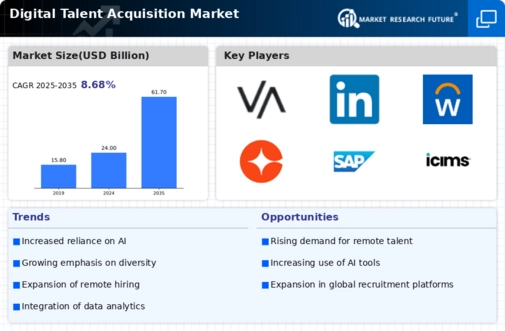Digital Talent Acquisition Market Summary
The Global Digital Talent Acquisition Market is projected to grow from 24.69 USD Billion in 2024 to 61.69 USD Billion by 2035.
Key Market Trends & Highlights
Digital Talent Acquisition Key Trends and Highlights
- The market is expected to expand at a compound annual growth rate of 8.96 percent from 2025 to 2035.
- By 2035, the market valuation is anticipated to reach 61.7 USD Billion, indicating robust growth potential.
- in 2024, the market is valued at 24.69 USD Billion, highlighting its current significance in the global economy.
- Growing adoption of digital recruitment technologies due to the need for efficient hiring processes is a major market driver.
Market Size & Forecast
| 2024 Market Size | 24.69 (USD Billion) |
| 2035 Market Size | 61.69 (USD Billion) |
| CAGR (2025-2035) | 8.68% |
Major Players
Entelo, LinkedIn, Workday, ADP, Cornerstone OnDemand, SAP, iCIMS, Avature, Oracle, Bullhorn, Harver, Dayforce, Greenhouse, BambooHR, IBM



 Source: Primary Research, Secondary Research, MRFR Database and Analyst Review
Source: Primary Research, Secondary Research, MRFR Database and Analyst Review




















Leave a Comment